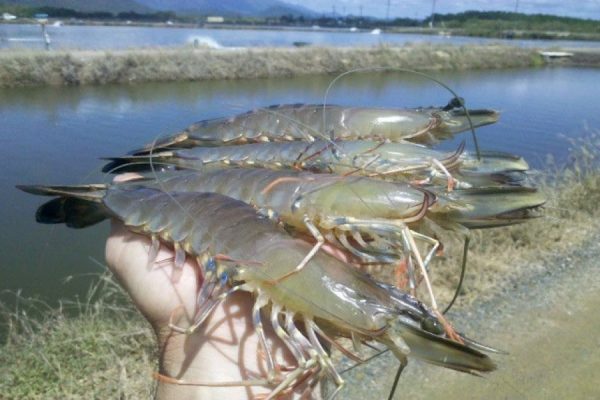
Bangladesh is a leading producer of the black tiger shrimp but productivity is only 341 kg per hectare. Source: thefinancialexpress.com.bd
Bangladesh should go for commercial cultivation of Penaeus vannamei species of shrimp which is also called the king prawn in Bangladesh to capture the global market. This was the subject of discussions by shrimp exporters and producers in a seminar at the Khulna’s Shrimp Tower.
In Bangladesh, vannamei shrimp is still at the pilot stage and at the seminar, the demand was for commercial cultivation of vannamei shrimp be allowed instead of running pilot projects. They added that vannamei shrimp currently accounts for 80% of global market share, where Bangladesh has no presence. Bangladesh is falling behind as commercial cultivation of the species is still far away.
Speakers at the seminar said that there is no alternative to vannamei shrimp as the production of tiger shrimp and freshwater prawn are decreasing in the country. To save the waning shrimp industry, government’s intervention is needed along with the permission to farm vannamei shrimp commercially. Exporters and cultivators have been unable to get loans, they said.
Bangladesh Frozen Foods Exporters Association has been appealing to the government for the last 20 years to allow the farming of vannamei shrimp to keep the shrimp industry alive.
As a result, the government allowed the pilot trials to farm this shrimp in September 2019. The project is being piloted at the Paikgachha Saltwater Center in Khulna under the Department of Fisheries and the Fisheries Research Institution. The average production is more than 9 tonnes per hectare.
The association provided statistics showing that the average production of tiger shrimp Penaeus monodon in Bangladesh is 341 kg per hectare. In neighbouring India, the average production of vannamei is 7,102 per kg hectare. This means that the production of vannamei is 6,761 kg more per hectare than that of tiger shrimp.
Vice President of Bangladesh Frozen Food Exporters Association S. Humayun Kabir said that due to lack of raw material (shrimp), only 28 out of 105 frozen fish processing and exporting companies in the country are operational and remaining have closed. The production is meeting only 10-15 % of the capacity of the companies and as a result, the processing cost is also increasing.
This industry has come to the brink of collapse. To revive this industry, there is no alternative to increasing production by farming vannamei shrimp. Fourteen other Asian countries have been exporting vannamei, he said. He demanded that permission be given for commercial production of vannamei shrimp and save the industry.
“Domesticated Shrimp Postlarvae – The Key To Success”
See more:
- New Tool Aims To Identify And Reduce Impact Of Chemicals And Diseases In Aquaculture
- 10 Percent Surge In China’s Seafood Retail Sales Due To Covid Measures
- Shrimp And Salmon Farmers Are Set For A Year Of Profits And Plenty

 Tiếng Việt
Tiếng Việt 中文 (中国)
中文 (中国)